These cute creatures can be called “pocket” animals not only because of their miniature size, but also because of their attachment to their owners. A tame squirrel is an excellent companion. She is happy to spend time near her owner. The fluffy membranes between the legs give the flying squirrels a cute charm, and the huge, moist eyes, reminiscent of agate, will melt the heart of an animal lover. This is why the flying squirrel is popular as a pet. Most often, Australian flying squirrels, also called sugar gliders, are purchased for keeping at home. What is a domestic flying squirrel? How to arrange their housing, feed and care for these exotic animals? You will find the answers in this article.
Description
In addition to the Australian continent, sugar gliders are found in New Guinea, Indonesia, and the southern islands of Japan. The squirrel flies from one tree to another, hovering in the air, thanks to large membranes connecting the front legs to the hind legs. These are skin folds-membranes covered with fur. The tail, long and fluffy, serves as a rudder for the possum. If necessary, the squirrel changes its flight direction. Squirrels have large eyes, which allows them to navigate well regardless of the time of day.
Females reach a length of 270-290 mm, males up to 400 mm. The weight of an adult individual, depending on gender, is 90-160 g. As a rule, the color of Australian flying squirrels is silver-blue. There are brown and yellowish individuals, and occasionally albinos. Externally, the possum resembles a small squirrel. Because of their love for sweets, these animals are called sugar squirrels.
The flying squirrel's muzzle is small, slightly elongated, with dark stripes. There are also stripes on the back of the animal. The belly is plain, white-cream in color. The eyes are surrounded by black rims that extend to the ears. The ears are large and turn towards the sound.
Features of reproduction
The reproductive characteristics of these animals are currently the object of close attention from many scientists studying the animal world. It is known that the mating season of flying squirrels begins in mid-spring. The duration of pregnancy is about a month. In one litter, the female usually brings no more than four cubs.
The cubs are born blind with no fur, and begin to see only at two weeks of age. During the first month of life, they gain strength from their mother's milk. She stays near them most of the day, since the baby squirrels can freeze due to the lack of warm fur. When squirrels are about two months old, they completely switch to an adult diet. In mid-summer, young offspring master the basics of the art of flight and independent living skills, after which they leave their parents’ nests
What is interesting about the domestic flying squirrel?
The popularity of sugar gliders as pets is due to the following reasons.
- Possums are very interesting to watch, especially if they live in a group.
- Affectionate, good-natured and not at all vindictive in nature.
- The domestic flying squirrel gets along well with other pets such as rabbits, hamsters, bunnies, and chinchillas. But cats are dangerous for possums.
- The sugar glider is a clean animal that takes care of its fur on its own.
Are there any disadvantages?
Like any living creature, the flying squirrel is not without some disadvantages.
- The sugar squirrel is a nocturnal animal, so it can make noise and interfere with sleep.
- The animal relieves itself anywhere, sometimes right on the fly. It is impossible to train a squirrel to do its “business” in a certain place.
- Males mark territory. The smell is very persistent. This is true if you are releasing an animal from its cage.
- Children should not be entrusted with caring for flying squirrels. The animal may bite or scratch a child if he carelessly picks up the possum.
- Domestic cats or large birds are dangerous to squirrels.
- Developing a complete diet for a possum is quite difficult.
Arrangement of the house
For housing, they need to equip a separate cage or container. It is necessary to design a home for a pet in such a way that it resembles a hollow made of cotton wool or fur.
The homemade house should be closed at the top and sides so that the baby squirrel feels safe and can get a good night's sleep.
Don’t be surprised if your pet puts some of its food and small treats in this hollow. Thus, he makes provisions to survive times of famine - this is how the action of natural instinct manifests itself.
Over time, squirrels that live in an apartment for a long time stop stocking up because they do not experience a shortage of food.
Conditions of detention
Flying squirrels are active animals that require significant space. The squirrel is an excellent runner, jumper, and even a flyer to boot. So you will need a lot of space. There are 2 options for placing sugar gliders.
- Cage size from 1 m3. At the same time, the pet will need daily “walks” outside the cage. You cannot leave an animal unattended. Due to uncontrolled movement around the room, the squirrel will not only create a mess, but also endanger itself.
- A specially made enclosure from which flying squirrels do not need to be released. This is a safer option. A good solution is a built-in aviary for squirrels from floor to ceiling. Place the enclosure in a dimly lit corner or niche, since bright light irritates the animals. You can use the red light to monitor your pets.
In any case, the cage or enclosure must be equipped with a reliable latch or be locked. Possums quickly learn to open simple latches and get out.
Number
The number of flying squirrels is small, hunting for it is limited. Fur is of little value. Despite the beauty and softness of the fur, it has a very thin and fragile inner core, which makes it difficult to use. It was believed that the flying squirrel does not take root well in captivity, but V.M. Smirin at the Zvenigorod biological station of Moscow State University kept flying squirrels of two subspecies in small enclosures for many years.
Fossil remains of the common flying squirrel (Pretomys volans) are known only from the end of the Late Pleistocene, although the remains of other species of the flying squirrel family (Pteromyidae) first appear from the Miocene, and the family flourished in the Miocene-Pliocene.
The species is listed in the Red Books of some regions.
Equipping a cage or enclosure
A mandatory element of the interior is houses purchased at a pet store or made from hollow logs. Flying squirrels love to change housing. They use 1-2 hollows as storerooms. A good option is a fabric hammock. However, it doesn't last long. The flying squirrel spoils it with its sharp teeth. For climbing, it is advisable to equip the enclosure with ropes and strong rope ladders.
The flying squirrel fills the house with hay, pieces of fur and moss. It is enough to place them in a cage. The animal itself will figure out what to do with them. Mandatory conditions are the presence of a drinking bowl and feeder.
Population and species status
The total number of common flying squirrels is too small, so hunting for such a rare representative of the flying squirrel subfamily and the genus Eurasian flying squirrels is currently limited. The fur of such a mammal as the common flying squirrel falls into the category of insufficiently valuable. Even despite the external attractiveness and softness of the fur, it is distinguished by a very thin and completely fragile inner layer, which can significantly complicate its active use.
In captivity, flying squirrels take root very poorly, since such a rodent will need to be provided with sufficient space for flying and jumping. However, their active catching for the purpose of selling them as domestic exotic is very popular in many areas. The total species population of the flying squirrel is currently significantly declining in some regions of Russia. It is for this reason that the flying squirrel was listed in the Red Book of some regions, including the pages of the Red Book of the Republic of Tatarstan.
Nutrition
The diet of flying squirrels consists of approximately 70% plant foods, most of which are fruits (mango, apple, melon, watermelon). The remaining 30% comes from protein foods. Basically, these are grain crops in the form of muesli and milk porridge.
The preferred vegetables are zucchini, cucumbers (seasonal only!), cabbage, and sweet carrots. You can put a tree branch with leaves in the cage. Animal food is also required: mealworms, green caterpillars without lint, grasshoppers, beetle larvae. If it is not possible to provide live food, you can temporarily replace it with boiled chicken fillet, cottage cheese, or a boiled egg. Low-fat yogurt, devoid of flavoring additives, is also beneficial for possums.
Sometimes it is useful to pamper the squirrel with 1-2 pieces of dried fruit (prunes should not be given!), 1-2 nuts, honey.
Approximate diet of a sugar glider for 1 animal
- Protein food: zoophobes (2 pcs.) or mealworms (6-8 pcs.).
- Boiled chicken or turkey fillet – 30 g.
- Fermented milk products - twice a week.
- Boiled quail egg without shell – once a week.
- Milk porridge, oatmeal or buckwheat with honey, fruit or candied fruits – once a week.
Soft bag
Fabric carriers have been around for a long time, but their modern development has primarily affected the increase in the number of all kinds of windows, mesh and other little things. The cat will no longer sit in a dark bag, not much different from an ordinary travel bag. It is difficult to organize a comfortable long trip in such a device. But for short distances the convenience is quite adequate.
The advantage of a soft cage is its lightness, compactness, and the ability to securely attach it to a car seat or, for example, to the handle of a suitcase.
Negatives: Not hygienic for long trips and difficult to clean quickly (although they can withstand washing in a regular washing machine).
Cost – 1,360 – 1,489 rubles.
Interesting Facts
Owners of pet possums will certainly be interested in these facts.
- The animal quickly becomes attached to the owner, recognizing him by smell. However, unfamiliar scents (cosmetics, perfume, lotion) often confuse your pet. Frightened by an unfamiliar aroma, a squirrel can show aggression and even bite its owner. Therefore, before picking up the baby, you need to wash them first.
- In the wild, the flying squirrel lives on average about 5 years. At home and with good care, the animal lives many times longer: up to 17 years.
- There is no need to vaccinate the animal, nor do you need to use antihelminthic drugs.
- The record recorded flight range of the sugar glider is 80 m.
- The squirrel's voice resembles a chirping squeak. A frightened or irritated animal purrs or makes a jerky clicking sound.
- The flying squirrel's fur is very beautiful, but of little value due to its low strength and difficulties in dressing.
- On the body, males have glands with an odorous liquid resembling musk. With its help, males mark their territory.
As you can see, flying squirrels require simple but constant care.
In addition, animals need a spacious room. Therefore, before purchasing an exotic pet, consider whether you are ready to provide the animal with proper care. If not, then it is better to refrain from purchasing. Exotic
Flying squirrel behavior
Flying squirrels are arboreal animals that rarely descend to the ground; only certain species live on the slopes of mountain gorges. Flying squirrels settle high in the treetops, where they fly from tree to tree. In captivity, life expectancy is 10-15 years, in natural conditions it reaches only 5 years.
The period of activity occurs at night. The flying squirrel spends most of its time searching for food. The nest is built at a height of 3 to 12 m, in tree hollows, rock crevices, or uses abandoned bird nests. It may settle next to humans, in birdhouses. The flying squirrel's nest is round in shape, built from soft lichen, moss, and dry grass.
Flying squirrels are non-aggressive social animals; they do not have distinct individual areas; they often live in pairs in nests. Only females show aggression during the period of feeding their offspring.
Diseases
The most common diseases of the Australian flying squirrel:
Aflatoxicosis
– liver disease caused by the ingestion of deadly aflatoxins (can be transmitted through flaxseed, corn, insects). If detected in time, the disease is completely curable by contacting a veterinarian. Symptoms: diarrhea, lethargy, apathy, loss of appetite.
Calcium deficiency
If not treated promptly, it transforms into paralysis of the hind limbs. To prevent the onset and development of the disease, you should maintain a balance of calcium and fluoride in the diet: ideally, it is a 2:1 ratio. To avoid illness, use calcium as a dietary supplement regularly. The dosage and exact name of the drugs can be clarified with the veterinarian or the breeder from whom the animal was purchased.
Constipation
Constipation is caused by stress, lack of fluids and fiber in the diet. Prunes and oranges can be used as first aid measures.
Diarrhea
Diarrhea can be caused by the abuse of laxative foods, stress, infectious diseases, or an individual reaction to a food product. As a treatment, it is necessary to identify and eliminate the root cause of the disease.
Dehydration
It is caused by loss of fluid due to insufficient water intake, vomiting, or frequent urination due to some diseases (for example, the genitourinary system). Dehydration of an animal for more than 12 hours can lead to death and requires immediate attention to a veterinarian. As an emergency measure, try offering your pet water sweetened with honey or drinking it yourself from a syringe without a needle.
Lifestyle
In the wild, these animals are distinguished by their nocturnal lifestyle. Flying squirrels go out in search of food in the late evening. Each individual has its own area of up to several hundred square meters, where it obtains food for itself. Animals behave very carefully and try to behave as quietly as possible in order to remain unnoticed. However, if you hear a crunching sound from the crown while walking through the forest, you can be sure that it is a squirrel feasting on nutritious seeds from the cones of coniferous trees.
It is quite rare to observe such rodents settling in one of the abandoned birdhouses not far from human habitats. A crevice in the rock can also provide a hiding place for a flying squirrel. It is not uncommon for flying squirrels to live in small communities consisting of several families. Like other squirrels, flying squirrels are not too fond of moving on the ground, where they can easily become prey for predators.
The animals themselves are not distinguished by aggressive behavior, and prefer not to pay attention to animals that do not pose any danger to them.
Interesting news. World News
It is important for any person to know the latest news in the world. Such information affects vacation planning, business contacts, the work of any person, and turns out to be important for the economy of the entire country or a single city.
The latest news in the world is the latest information that covers events that happened hours or even minutes ago. You can make sure that we regularly update the feed, indicating the date and time of publication of reports and articles. Here you can find out all the news of the day in the world, no matter what area they concern. Important events require constant coverage, so we are constantly adding new facts, interviews, and expert comments that are important for covering such information.
All world news is collected in the corresponding section of PiterTV, so that residents of St. Petersburg can receive the most complete information about everything that is important, interesting, and necessary. We talk about all incidents, natural disasters, political meetings, cultural and economic news of global importance
Winter diet
Of course, from the fall the animals prepared huge reserves until spring. Therefore, in winter, they will eat only what they managed to collect. And these are nuts, seeds, pieces of bark, buds.
This food is eaten by both wild and domestic animals. But for your family, you can sometimes give them treats, such as dry berries or fruits. But most importantly, in small quantities:
- in one day, the animal’s food intake is approximately 30-40 grams;
- vegetables from them should be about 15 grams;
- protein feed-gram 10;
- and everything else is seeds, nuts, etc.
Electric models
Beginners should pay attention to more innovative gadgets. They are definitely a little more expensive
But in this case, the price increase proportionally affects safety.
We are talking about a family of rechargeable machines equipped with a rotating head. They do not cut, but grind down the cornea. With this approach, it is almost impossible to harm a dog or cat by catching too much of a nail. The high rotation speed of the tip ensures fast operation, and the low noise level does not bother four-legged patients at all. Any beginner can easily cope with such a mechanism.
Price – 481 – 1,859 rubles.
Some models are equipped with 2-3 heads, suitable for dogs or cats of various breeds and age groups.
After all, the claws of a dwarf poodle are much more delicate than those of a German shepherd. The same applies to young kittens and adult cats - their paws need to be treated with different elements. So, when purchasing a tool for trimming claws, you should consider this nuance.
Cost – 567 – 1,189 rubles.
The final touch is the rotation speed of the device head.
It directly affects the quality of claw grinding. After all, it is necessary not only to cut off the ends, but also to polish the ends so that the sharp edges do not injure the delicate pads of the paws. This operation is best done in a more gentle mode at low speeds. So a machine with gear shifting will come in very handy in this case.
Price – 497 – 1,566 rubles.
I like it I don't like it
Hand feeding
When feeding young animals, wrap them in a warm towel and keep them on their stomachs with their heads up (never on their backs or in an upright position). This will help prevent the mixture from being inhaled into your lungs. Using a 1 - 3 volume syringe, feed the animal very slowly and evenly to prevent it from inhaling the food.
The syringe should be held firmly in the hand using the hitchhiker's position (thumb on the plunger and all fingers wrapped around the shaft and barrel of the syringe). The caregiver should monitor the plunger at all times.
How to feed a baby squirrel
For very small mammals, the formula is administered drop by drop. The maximum comfortable stomach capacity in most mammals is 5-7% of body weight, except for rabbits (10-12.5%), it should not be exceeded.
Young mammals do not drink milk well when it has become cool; cold formula can cause bloating. Check the temperature on the inside of your wrist and with a thermometer each time you fill the syringe and before placing it in your pet's mouth.
To keep formula warm over multiple feedings, try placing the container in a mug of warm water. Maintain the temperature around 37°C. If you use a meat thermometer, the temperature will be slightly higher.
Avoid sudden changes in diet as this may cause problems. Follow the recommended feeding schedule for the species, age, and weight of the animal. For example:
- 4 X DAY = 8am, noon, 4:30pm, 9:00pm;
- 3 X DAY = 8:00, 14:00, 20:00;
- 2 X DAY = 8:00 and 8:00;
- 1 X DAY = 8:00.
Weaning from formula (5-8 weeks)
Lure
Weigh the animal, follow a feeding schedule for size and age
It is extremely important not to overfeed. Additionally, add a bowl of porridge, a small amount of the mixture mixed with baby cereal
The consistency should be thick.
Be careful not to stain the fur with the porridge. If it gets dirty, wipe the skin with a damp sponge or cloth. Offer this dish throughout the day and remove it after feeding.
Monitor animals closely for hair loss. Sneezing, coughing, or other abnormal breath sounds indicate aspiration (food entering the lungs). If this happens, stop bowl feeding for a few days.
Learn more 10 simple tips for cleaning your home from pet hair
Between formula feedings, offer your squirrel a small amount of soaked food, paw-sized pieces of apple, sweet potatoes, broccoli, green beans, corn on the cob, and unshelled nuts. Add only 1 new product per day.
If diarrhea occurs, stop eating new foods immediately. Then try a new product after 2 - 3 days.











